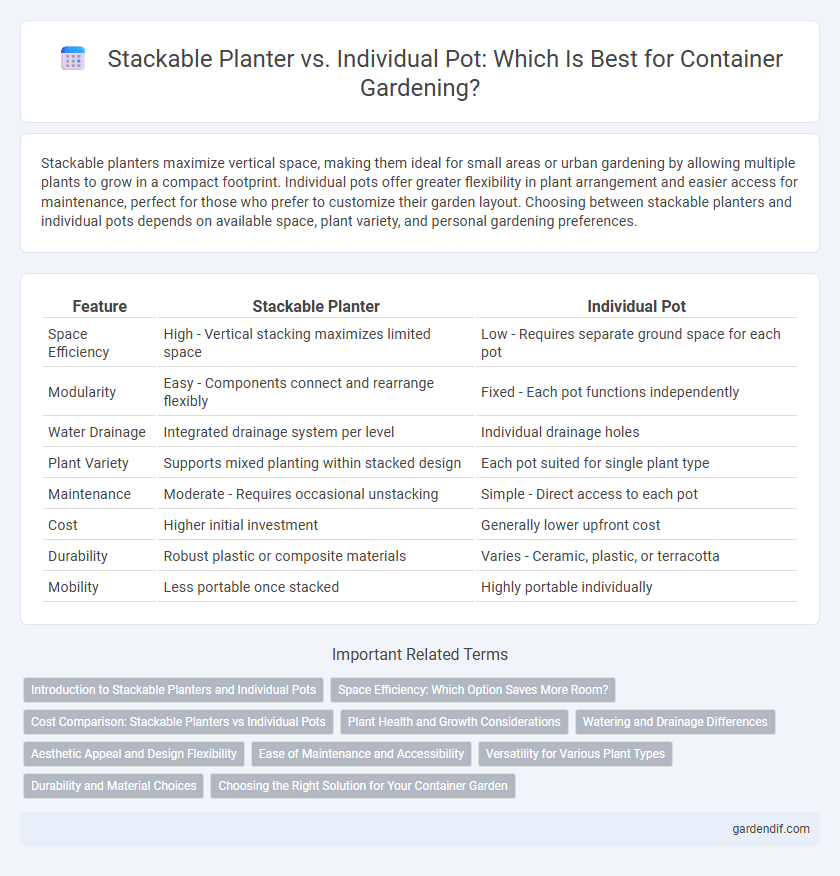
Stackable Planter vs Individual Pot Illustration
Stackable planters maximize vertical space, making them ideal for small areas or urban gardening by allowing multiple plants to grow in a compact footprint. Individual pots offer greater flexibility in plant arrangement and easier access for maintenance, perfect for those who prefer to customize their garden layout. Choosing between stackable planters and individual pots depends on available space, plant variety, and personal gardening preferences.
Table of Comparison
| Feature | Stackable Planter | Individual Pot |
|---|---|---|
| Space Efficiency | High - Vertical stacking maximizes limited space | Low - Requires separate ground space for each pot |
| Modularity | Easy - Components connect and rearrange flexibly | Fixed - Each pot functions independently |
| Water Drainage | Integrated drainage system per level | Individual drainage holes |
| Plant Variety | Supports mixed planting within stacked design | Each pot suited for single plant type |
| Maintenance | Moderate - Requires occasional unstacking | Simple - Direct access to each pot |
| Cost | Higher initial investment | Generally lower upfront cost |
| Durability | Robust plastic or composite materials | Varies - Ceramic, plastic, or terracotta |
| Mobility | Less portable once stacked | Highly portable individually |
Introduction to Stackable Planters and Individual Pots
Stackable planters maximize vertical space by allowing multiple planting containers to be securely stacked, ideal for small balconies or urban gardens. Individual pots provide flexibility in plant arrangement and make it easier to manage watering and soil needs specific to each plant. Choosing between stackable planters and individual pots depends on available space, plant variety, and maintenance preferences.
Space Efficiency: Which Option Saves More Room?
Stackable planters create vertical gardening space by allowing multiple plants to be grown in the footprint of a single pot, maximizing limited areas such as balconies or small patios. Individual pots require separate surfaces for each container, which can lead to clutter and inefficient use of horizontal space. Choosing stackable planters enhances spatial efficiency, making them ideal for gardeners with limited room seeking to optimize plant density.
Cost Comparison: Stackable Planters vs Individual Pots
Stackable planters generally offer a more cost-effective solution compared to individual pots due to their compact design, reducing the need for additional shelving and maximizing vertical space. Individual pots may incur higher expenses over time because each requires separate purchase, maintenance, and space allocation, increasing overall costs. Bulk purchasing of stackable planters often results in discounted prices, further enhancing their affordability for large-scale gardening projects.
Plant Health and Growth Considerations
Stackable planters enhance plant health by promoting efficient drainage and aeration, which reduces root rot risks compared to individual pots. Their modular design supports vertical growth without overcrowding roots, facilitating better nutrient absorption and overall development. In contrast, individual pots may restrict root expansion and require frequent repotting to maintain optimal plant health and growth.
Watering and Drainage Differences
Stackable planters feature integrated drainage systems that channel excess water from upper tiers to lower ones, promoting efficient water use and preventing root rot. Individual pots require separate watering and drainage management, often leading to uneven moisture levels and potential overwatering. Stackable designs optimize drainage flow, reducing water waste compared to the isolated drainage of individual containers.
Aesthetic Appeal and Design Flexibility
Stackable planters offer a sleek, modern aesthetic ideal for compact spaces, allowing vertical garden arrangements that maximize greenery without sacrificing style. Individual pots provide greater design flexibility through varied shapes, sizes, and materials, enabling personalized plant displays that cater to diverse decor themes. Choosing between stackable planters and individual pots depends on desired visual impact and available space for creative planting solutions.
Ease of Maintenance and Accessibility
Stackable planters streamline garden management by consolidating multiple plants into a compact vertical arrangement, significantly reducing watering and pruning time compared to handling individual pots. Their modular design allows easy access to each plant tier without the need to move heavier containers, enhancing convenience for routine care. In contrast, individual pots provide straightforward access for each plant but require more floor space and separate maintenance efforts, increasing overall gardening labor.
Versatility for Various Plant Types
Stackable planters maximize vertical gardening space, allowing diverse plant species like herbs, succulents, and trailing vines to thrive in limited areas. Individual pots offer flexibility for varying root depths and plant sizes, accommodating delicate plants needing separate environments to prevent root entanglement and disease spread. Choosing between stackable planters and individual pots depends on the grower's spatial constraints and the specific care requirements of different plant types.
Durability and Material Choices
Stackable planters typically feature high-quality, weather-resistant materials such as reinforced polypropylene or metal alloys, enhancing durability for outdoor and indoor use. In contrast, individual pots offer a wider variety of materials including ceramic, terracotta, and plastic, each with differing levels of durability and susceptibility to cracking or fading. The modular design of stackable planters often promotes better structural integrity and space efficiency compared to single pots prone to chipping and material wear.
Choosing the Right Solution for Your Container Garden
Stackable planters maximize vertical space and improve drainage, making them ideal for small balconies or patios, while individual pots offer more flexibility in plant arrangement and soil customization. Selecting the right container depends on factors like available space, plant types, and maintenance preferences. Assess your garden's layout and watering needs to determine whether stackable units or standalone pots best support plant growth and ease of care.
Stackable Planter vs Individual Pot Infographic

 gardendif.com
gardendif.com